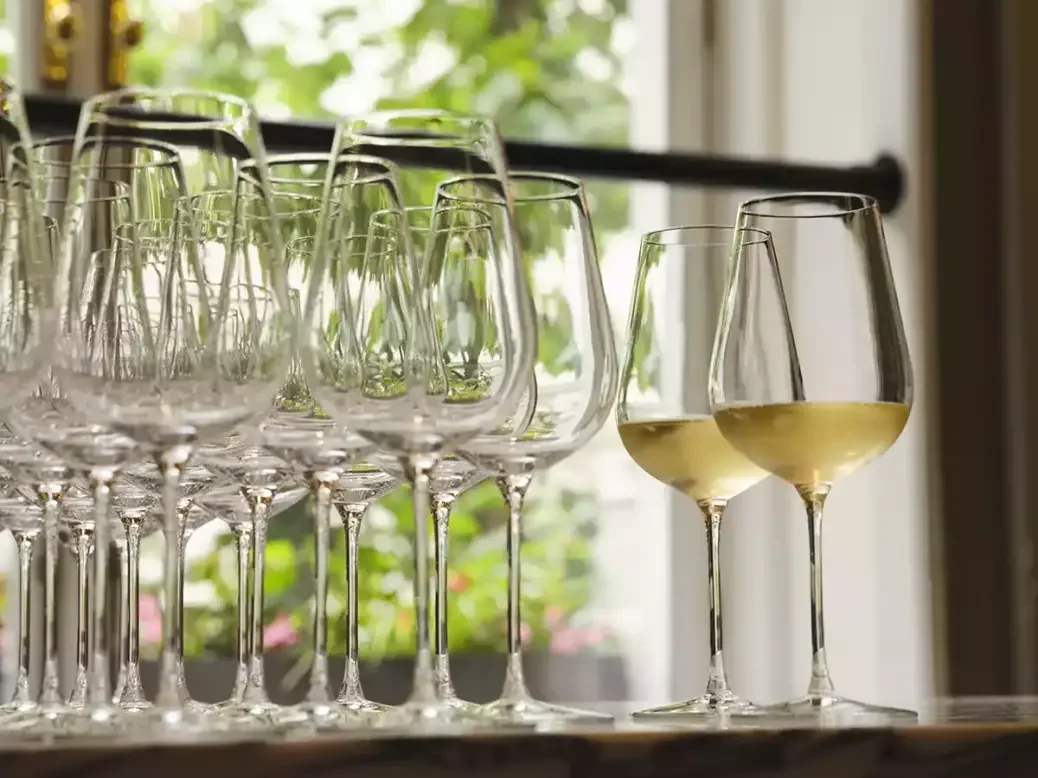
The Robinson x Brendon Precision Glass is the latest wine glass to aspire to make the best of all possible wines. But where does that leave the market for hyper-specific glassware? Eleanor McNeill investigates
Earlier this summer, Jancis Robinson OBE MW and Richard Brendon added a new glass to their collection. The Precision Glass has the same design as their Original Glass, but is machine-made, and is a response to the latter’s success: “We have listened to what the people want,” says Robinson, “that is, all the precise wine expression offered by our beautiful wine glass, plus a bit more durability and the value possible with a machine-made version. Et voilà: the Precision Glass.”
The Original Glass was designed on the principle that one glass could suit all wines, from Port to Prosecco. Anne Krebiehl MW, writing for WFW on the Judgment of London event earlier this year, believes that it “lives up” to that aspiration. The Precision Glass promises, by using machine-cutting rather than artisanal mouth-blowing, to deliver that same versatility at half the price point ($116 / £90 for four, where the Original Glass was $116 for two). Its name is a nod to the greater uniformity of dimension and weight that comes with using machines, as compared to the Original, whose name is not only a statement of the fact that it was released first, but also acknowledges the one-of-a-kind nature of handmade glassware. Greater uniformity can only be positive in a glass that champions the ideal of a single perfect design, but machine-manufacture does come with the drawback of producing slightly thicker glasses. On the one hand, this makes them more durable, as the marketing for the Precision stresses. On the other hand, the Precision lacks some of the gossamer-thin delicacy that makes her sister glass so beautiful. The Original Glass is undoubtedly the nicer glass but, for half the price, the Precision offers a drinking experience that is well over half as good.
As well as being a beautiful object worth reviewing and buying, though, the Precision Glass also points to an interesting trend within the glassware space. For it is not the only machine-made, would-be-everything glass that has been released lately. In 2022, Riedel, famous for being “the first in history to recognize that the taste and aroma of a beverage is affected by the shape and size of the vessel from which it is consumed,” came out with the Riedel Veloce All Purpose tumbler, which, it says, “is perfect for all kinds of beverages, including wine and cocktails.” Other brands, too, are moving toward this universal glass model: Schott Zwiesel has a new MioVino red wine glass, that, in contradiction of its name, the website describes as “the modern all-rounder,” suitable both for still reds and sparkling wines; it also sells a range of “All Round” glasses; Spiegelau sells a Universal Glass in many of its collections; the Zalto range (initially named Denk-Art after Hans Denk, the famous priest and wine expert who designed them) and Kurt Joseph Zalto’s Josephinenhütte set also both include a Universal; and Conterno’s Sensory Glass is, according to The Rare Wine Company, “as amazing with a Roulot Meursault or Selosse Lieu-Dit as it is with Monfortino.” When asked, Schott Zwiesel acknowledges a “certain trend” toward all-round glasses, and Spiegelau CEO, Richard Voit, tells me candidly, “It is a trend. I don’t think it will last forever.”
The cult of the universal wine glass
Over and over, we are seeing companies, some of which have spearheaded the idea of different glasses for different wines, release glasses that aspire to do it all. Now, more than ever, seems a good time to examine the cult of the universal wine glass.
Riedel built its brand on the assertion that different wines deserve different glasses: one for Champagne, one for Old World Pinot Noir, one for unoaked Chardonnay, one for New World Shiraz, et cetera, ad infinitum. It is easy to roll one’s eyes at this specificity and dismiss it as a genius marketing ploy, for who could ever own the perfect glass for any and every wine they drink? If we have a New World Shiraz glass, surely we also need a glass specifically designed for the Henschke 2017 Shiraz, which is considerably less full-bodied than, say, the same winery’s 2016 offering? By fussing over wine vessels, we add yet another variable to the already complex process of wine appreciation. But then, since when has fine wine ever been limited by such mundane practicality as possibility? The shape of a glass does affect the aroma and flavor of the wine within it, with different surface areas concentrating aromas either less or more, and exposing the wine to the air in a different way. In an industry in which so much attention is paid to the minutiae of terroir, rootstock and vine material, yeasts, blending, maturation vessels, storage, serving temperature, and so on, why should we fall at the last hurdle, and drink from just any glass? It may be an impossible task to find the perfect match between wine glass and wine, but why should that stop us from trying? To be a lover of fine wine is, one could say, to be always seeking unattainable perfection, whether in terroir, in vintage, or in glass. From this search stems its challenge, and a large part of its joy.

There is, then, a perfectly valid case to be made that the fine-wine community should be paying close attention to the glasses it uses. Indeed, Riedel would have us say “wine instruments,” a phrase that, while unlikely ever to come into regular use, does get across the extent to which the wine glass is the receptacle from which we drink and that ultimately makes the wine function, just as it is a wind instrument that makes the air we blow, sing. All the same, while there is certainly a place for glasses with a specific aim, most people do not have the time, money, or cupboard space for a thousand different glasses. Concessions have to be made.
And they have been, by seemingly every big name in the business and their purportedly universal glasses. There is a powerful attraction in the idea of never again having to decide whether to use the Burgundy ballon or more conical crystal, the flute or the coupe. “Universal” glasses are often designed particularly with young people and more casual enthusiasts in mind—Richard Voit says that, while he himself subscribes to the view that different grapes merit different glasses (especially in the cases of Pinot Noir and Burgundy), Spiegelau recognizes that some customers want only one style of glass, and so caters to this wish. Similarly, Zwiesel Kristallglas has two brands under its banner: Zwiesel Glas sells premium glasses that are often quite specialized, while Schott-Zwiesel offers entry-level price points and “tends to appeal to younger people.” It is under this latter banner that it offers “all-round” and more versatile glasses. There is, it says “a market for both” philosophies—and why shouldn’t it provide for both?
Yet, despite their obvious usefulness, and the obvious sense in producing them, there is, perhaps, something fundamentally contradictory about these companies’ universal glasses. In the case of Zalto, Schott Zwiesel, Spiegelau, and Riedel, the universal glasses appear on their websites alongside a series of glasses whose product descriptions espouse the philosophy of the specific (and, in the case of Riedel, uber-specific) glass. The product descriptions of the “universal” glasses themselves, meanwhile, often reveal a far more limited capability than that moniker suggests. The Zalto Universal, for example, is “for expressive, medium to full-bodied wines with fine minerality and subtle aromatics.” It is recommended for Riesling, Grüner Veltliner, Chianti, Chardonnay (but only if it is mineral-edged), and sparkling wines (but only if they are complex). This rather stretches the definition of universal, and is somewhat reminiscent of musicians whose “world” tours cover North America, Western Europe, and Melbourne. “Universality” comes across as a convenient marketing tool, tapping into consumers’ wish for simplicity and clarity, rather than a genuine belief in the glasses’ versatility.
Precision gumption
This brings us back to the glass that sparked this piece. Jancis Robinson’s and Richard Brendon’s Precision Glass at the very least has gumption—the gumption to aim to express all wines at their best (rather than most wines at their most unobjectionable), and the gumption to be the only wine-glass style sold by the pair (the choice between it and the Original Glass is between two price points, not between two fundamentally different glasses, even if there may be subtle differences based on the different manufacturing processes and the thickness of the glass). It can afford to have this gumption because Richard Brendon is underwritten by a different business model to the companies mentioned earlier; it is a tableware company with a glassware line, not a glassware company. It therefore does not have to cater to a wide range of consumer bases, from wine enthusiasts, to casual enjoyers. The Original/Precision can thus legitimize the company’s claim that it is the only wine-glass shape you need, by being the only wine-glass shape that it needs to sell. Here is universality as conviction rather than jargon; as an ideal rather than as an advertising term. One need not necessarily believe in the existence of a unicorn universal wine glass to appreciate the aspiration to make one. There is a refreshing dedication about the Precision Glass; a commitment to the concept, when so many other designers and manufacturers seem to hedge it with myriad other glasses, or caveats to the versatility of their universal glasses.
Universality is an idea, moreover, that has always been at the heart of Richard Brendon. The company was founded with a collection of mirrored tea cups that could be paired with any saucer and provide a perfect match. How fitting, then, that it is this company that has produced the Precision Wine Glass, designed to be a perfect match for any wine.






